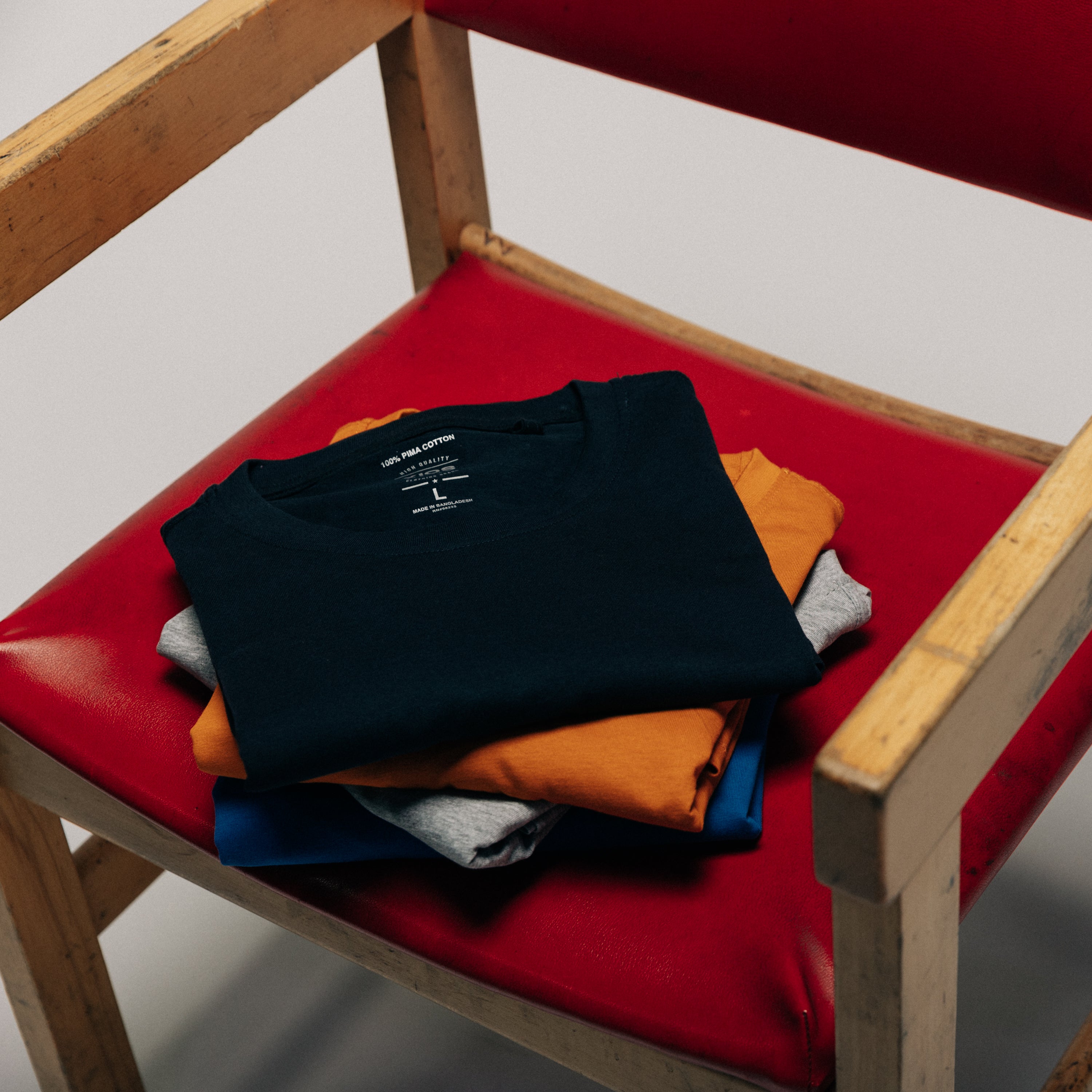How To Soften A T-Shirt Without Much Effort

T-shirts are the quintessential element of casual wear, known for their versatility and ability to complement almost any outfit. However, not all t-shirts offer the same level of comfort right off the bat. Some may feel stiff and unwelcoming against the skin, necessitating a softening process to enhance their wearability. If you are wondering how to soften t-shirts and make them more comfortable without expending too much effort, you are in the right place. Let us explore simple yet effective methods to achieve that desired softness in your favorite tees, ensuring they are a joy to wear every time.
Understanding T-Shirt Fabric
Before diving into the softening methods, it is crucial to understand that the fabric of your t-shirt plays a significant role in how it feels. Cotton, polyester, and blends thereof are the most common materials used in t-shirt manufacturing.
Each fabric type has its unique properties and responds differently to softening techniques. Cotton is naturally soft and tends to become even softer with regular washing, whereas polyester might require a bit more attention to achieve a similar level of softness. Recognizing the material composition of your t-shirt is the first step towards choosing the most effective softening method.
How To Soften T-Shirts in 8 Ways
Washing and Drying
One of the simplest ways to soften a t-shirt is through the washing and drying process. Surprisingly, the way you wash and dry your clothes can significantly impact their texture and softness. For an effortless approach, consider using mild detergents and opting for a gentle wash cycle. Harsh chemicals found in some laundry detergents can strip the fabric of its natural softness, leaving it feeling stiff and scratchy.
After washing, the method of drying your t-shirts can also influence their softness. While air drying is the most gentle option, it might not always be the most practical. If you are using a dryer, throw in a couple of clean tennis balls or dryer balls. These balls bounce around during the drying cycle, helping to break up laundry clumps and soften the fabric. Additionally, setting your dryer to a lower heat can prevent the fibers in your t-shirt from becoming too tight and stiff, ensuring they come out feeling soft and comfortable.
Natural Softening Agents
For those who prefer a more natural approach to fabric care, incorporating natural softening agents into your laundry routine can be a game-changer. Vinegar, for instance, is a fantastic natural softener that can be added to the rinse cycle of your wash. Its acidic properties help to break down detergent residues that can stiffen the fabric, leaving your t-shirts feeling soft and fresh without the use of synthetic chemicals.
Baking soda serves as another superb natural fabric softener. Incorporating half a cup of baking soda into the wash cycle of your washing machine can effectively soften the fibers of your t-shirt. Baking soda also has the added benefit of neutralizing odors, ensuring your clothes come out smelling clean and feeling soft.
The Saltwater Soak
An age-old trick that remains effective to this day is the saltwater soak. This method involves dissolving a generous amount of salt in a basin of water and soaking your t-shirt for a few hours or overnight. Salt acts as a natural fabric softener, breaking down the stiff fibers and making the material more pliable and comfortable to wear. After soaking, simply wash your t-shirt as usual, and you will notice a significant improvement in its softness.
Embracing the Break-In Period
Sometimes, the simplest way to soften a t-shirt is to simply wear it. Through normal use and subsequent washings, fabrics naturally break down and become softer. This is particularly true for cotton and cotton-blend shirts, which tend to loosen up and offer a more comfortable fit over time. If you prefer a more hands-off approach, regular wearing and laundering might be all you need. This method allows the fabric to naturally achieve a softer texture, enhancing the comfort with each wear.
The Freezer Method
An unconventional but effective technique involves using your freezer. Wet your t-shirt, wring out the excess water, then place it in a plastic bag and freeze it overnight. The fibers in the fabric expand when frozen and contract when thawed, which can help to soften the material. Once thawed, wash the t-shirt as you normally would. This method is particularly useful for t-shirts that feel overly stiff or have shrunk slightly after washing.
Fabric Conditioners and Softeners
While natural methods are preferred by many, fabric conditioners and softeners can also play a significant role in achieving the desired softness. These products are specifically designed to soften fibers, making them a convenient option for those looking to streamline their laundry process. However, it is important to use these products sparingly, as overuse can lead to buildup on the fabric, which might actually reduce the garment’s ability to breathe and absorb moisture. A small amount added to the rinse cycle can make a noticeable difference in the softness of your t-shirts.
Mechanical Action: The Pumice Stone Trick
For a more hands-on approach, consider using a pumice stone. This method is particularly effective for targeting specific areas of a t-shirt that may feel rougher or stiffer than others. Gently rubbing a dry, clean pumice stone over the fabric can help to loosen stiff fibers, making the material softer. Be cautious not to overdo it, as vigorous scrubbing can damage the fabric. This technique is best suited for durable materials and should be followed by a regular wash to remove any loosened fibers.
The Importance of Proper Storage
How you store your t-shirts can also impact their softness. Avoid hanging them on wire hangers, which can stretch the fabric and lead to misshapen garments. Instead, fold them neatly and store them in a drawer or on a shelf. This helps to maintain the integrity of the fibers and prevents unnecessary stretching or strain on the material, keeping your t-shirts soft and ready to wear.
Professional Tips for Long-Lasting Softness
To ensure your t-shirts stay soft over the long term, consider these additional tips:
- Avoid High Heat
High temperatures in the laundry process can significantly affect the softness and durability of your t-shirt fibers. When exposed to high heat, whether in the washing machine or dryer, the fibers within your t-shirts can contract and, over time, become hard or brittle. This not only diminishes the comfort of your garment but can also lead to shrinkage and a loss of shape, reducing the overall lifespan of your favorite tees.
To avoid such outcomes, it is crucial to select low-heat settings when laundering your t-shirts. Washing in cold water is often enough for cleaning everyday wear, while tumble drying on a low or air-only cycle can help preserve the fabric's natural softness and prevent shrinkage. By adhering to these gentler laundering methods, you will ensure your t-shirts remain comfortable and in good condition after wear.
- Limit Exposure to Chlorine Bleach
While bleach is a common go-to for whitening whites and removing stubborn stains, chlorine bleach can be particularly harsh on fabric fibers. Its strong chemical composition can weaken fibers, leading to a noticeable decrease in the softness of your garments over time. Furthermore, regular use of chlorine bleach can strip away the color from your t-shirts, leaving them looking faded or discolored.
To keep your t-shirts bright and soft, opt for non-chlorine, color-safe bleaches when necessary. These alternatives are less aggressive on fabrics and are designed to safely brighten or disinfect your clothes without the damaging effects of chlorine. Incorporating these gentler options into your laundry routine will help maintain the vibrant colors and plush texture of your t-shirts, ensuring they feel as good as they look.
- Rotate Your Wardrobe
Wearing the same t-shirts repeatedly can subject them to rapid wear and tear, compromising their softness and structural integrity. Just like any other part of your wardrobe, t-shirts need a break to maintain their condition. Regularly rotating the t-shirts you wear can significantly reduce the strain on any single garment, evenly distributing wear across your collection. This practice not only extends the life of your t-shirts but also preserves their shape and softness.
By giving each t-shirt adequate rest between wears and ensuring a varied use of your wardrobe, you help maintain the fabric's resilience and prevent premature aging. Additionally, rotating your wardrobe allows you to enjoy the full range of your clothing, giving life to all your pieces and ensuring each t-shirt remains a cherished part of your attire.
XIOS America, a brand known for its premium quality and stylish clothing options, including an array of short-sleeve tees and long-sleeve tees, understands the importance of comfort in everyday wear. Our commitment to ensuring our customers enjoy not only the best designs but also unparalleled comfort, has led us to share insights into softening t-shirts effortlessly. Whether your preference lies in short-sleeve or long-sleeve tees, following these guidelines will ensure your XIOS America garments maintain their quality while becoming even more comfortable over time.



